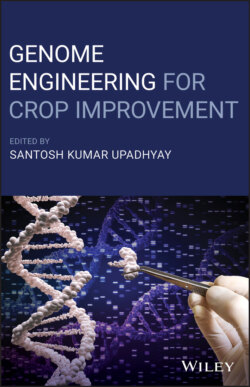Читать книгу Genome Engineering for Crop Improvement - Группа авторов - Страница 2
Table of Contents
Оглавление1 Cover
2 Title Page
3 Copyright Page
4 Dedication Page
5 List of Contributors
6 Preface
7 About the Editor
8 Acknowledgments
9 1 An Overview of Genome‐Engineering Methods 1.1 Introduction 1.2 ZFNs 1.3 TALENs 1.4 CRISPR‐Cas System 1.5 CRISPR‐Cpf1 1.6 Conclusions Acknowledgements References
10 2 Distribution of Nutritional and Mineral Components in Important Crop Plants 2.1 Introduction 2.2 Exploring Nutrient Distribution in Grain 2.3 Exploring the Mineral Distribution in Grain 2.4 Prospect Acknowledgement References
11 3 Application of Genome Engineering Methods for Quality Improvement in Important Crops 3.1 Introduction 3.2 Evolution and Historical Perspective of Genome Engineering 3.3 CRISPR/Cas Genome Editing Systems 3.4 Application of CRISPR/Cas System for Crops Quality Improvement 3.5 Regulatory Measures for Genome Engineering Crops 3.6 Conclusion Acknowledgement References
12 4 Genome Engineering for Enriching Fe and Zn in Rice Grain and Increasing Micronutrient Bioavailability 4.1 Introduction 4.2 Genes Related to Uptake of Fe and Zn from the Soil 4.3 Fe and Zn Biofortification using the SDN‐1 Approach 4.4 Fe and Zn Biofortification Using the SDN‐2 Approach 4.5 Fe and Zn Biofortification Using the SDN‐3 Approach 4.6 Future Thrust and Implications of SDN‐1, ‐2, and ‐3 References
13 5 Development of Carotenoids Rich Grains by Genome Engineering 5.1 Introduction 5.2 Nutritional Quality Improvement Through Pathway Engineering 5.3 Crop Improvement through Genetic Engineering Techniques 5.4 Improvement of Carotenoid in Grain Crops through CRISPR/Cas9 5.5 Improvement of Carotenoid in Grain Crops Through RNAi 5.6 Future Perspectives and Conclusion References
14 6 CRISPR‐Cas9 System for Agriculture Crop Improvement 6.1 Introduction 6.2 Genome Engineering 6.3 Tools for Genome Engineering 6.4 CRISPR/Cas Beyond Genome Editing 6.5 CRISPR/Cas and Crop Improvement 6.6 Application of Genome Engineering Tools in Metabolic Engineering 6.7 Future Prospective References
15 7 Contribution of Crop Biofortification in Mitigating Vitamin Deficiency Globally 7.1 Introduction 7.2 Effect of Vitamins on Human Health and Their Sources 7.3 Plan Biofortification to Overcome Vitamin Deficiency 7.4 Conclusion Acknowledgments References
16 8 Genome Editing Approaches for Trait Improvement in the Hairy Root Cultures of the Economically Important Plants 8.1 Introduction 8.2 Secondary Metabolites and Hairy Root Culture: An Insight 8.3 Genome Editing Process in Plants 8.4 Plant Hairy Root Culture as a Model for Genome Engineering 8.5 Conclusions Acknowledgements References
17 9 Phytic Acid Reduction in Cereal Grains by Genome Engineering 9.1 Introduction 9.2 Genes Involved in Phytic Acid Biosynthesis 9.3 Potential Targets and Strategies to Achieve Low Phytate Wheat 9.4 Evolution of Genome Engineering for Trait Development in Wheat 9.5 Future Implications Acknowledgements References
18 10 Genome Engineering for Nutritional Improvement in Pulses 10.1 Introduction 10.2 Need for Nutritional Improvement in Pulses 10.3 Nutritional Defects in Pulses Targeted for Genetic Engineering 10.4 Genome Engineering as an Alternate to Conventional Breeding 10.5 Conclusive Discussion References
19 11 The Survey of Genetic Engineering Approaches for Oil/Fatty Acid Content Improvement in Oilseed Crops 11.1 Background 11.2 Soybean: Triumph Oil Crop 11.3 Camelina sativa: Biofuel and Future Ready Crop 11.4 Conclusion Acknowledgments References
20 12 Genome‐Editing Mediated Improvement of Biotic Tolerance in Crop Plants 12.1 Introduction 12.2 Plant Defense Response 12.3 Genome Engineering Tools for Engineering Disease Resistance References
21 13 Genome Engineering and Essential Mineral Enrichment of Crops 13.1 Introduction 13.2 Root Engineering of Cereals: A Promising Strategy to Improve Nutrient Efficiency, Biofortification, and Drought Tolerance 13.3 Use of Genome Edited Plants in Phytoremediation 13.4 Genetic Engineering and Crop Biofortification 13.5 Genome Engineering Technology and Its Use in Essential Mineral Enrichment of Crop Plants 13.6 Conclusion References
22 14 Genome Editing to Develop Disease Resistance in Crops 14.1 Introduction 14.2 Traditional Approaches to Develop Disease Resistance in Crops 14.3 Genome Editing‐a New Way Forward 14.4 Genome Editing Examples to Develop Disease Resistance in Crops 14.5 Recent Trends in Genome Editing 14.6 Conclusion and Prospects References
23 15 Biotechnological Approaches for Nutritional Improvement in Potato (Solanum tuberosum L.) 15.1 Introduction 15.2 Genetic Transformation of Potato 15.3 Protein Engineering of Potato for Protein Content 15.4 Genetic Engineering of Potato for Starch Modification 15.5 Lipids Biosynthesis Engineering in Potato 15.6 Vitamins Genetic Engineering in Potato 15.7 Metabolic Engineering of Potato for Enhanced Mineral Content 15.8 Pathway Engineering for the Functional Secondary Metabolites 15.9 Future Prospective and Conclusions References
24 16 Genome Engineering Strategies for Quality Improvement in Tomato 16.1 Introduction 16.2 Genome Editing Systems in Plants 16.3 Current Applications of Genome Editing in Tomato Improvement 16.4 Challenges and Future of Genome Editing in Tomato References
25 17 Genome Editing for Biofortification of Rice 17.1 Introduction 17.2 Genome Editing and its Tools 17.3 Genome Editing for Biofortification of Rice 17.4 Genome Editing for Improvement of Agronomic Traits in Rice 17.5 Conclusion and Future Aspects Acknowledgment Conflicts of Interest References
26 18 Genome Editing for Improving Abiotic Stress Tolerance in Rice 18.1 Introduction 18.2 Recent Developments in Genome Editing Technology 18.3 Challenges of Different Genome‐Editing Systems 18.4 Application of Genome‐Editing Technology for the Improvement of Abiotic Stress Tolerance in Rice 18.5 Challenges of Genome Editing in Rice 18.6 Conclusion and Future Prospects Acknowledgment Conflicts of Interest References
27 19 Role of Genome Engineering for the Development of Resistant Starch‐Rich, Allergen‐Free and Processing Quality Improved Cereal Crops 19.1 Introduction 19.2 Starch Characteristics 19.3 Starch Biosynthesis 19.4 Starch Digestibility and Resistant Starch 19.5 Genetic Modification in Relation to RS 19.6 Genetic Modification in Relation to Allergen‐Free Cereals 19.7 Genetic Modification in Relation to Improved Processing Quality Cereals 19.8 Conclusions Acknowledgments References
28 20 Engineering of Plant Metabolic Pathway for Nutritional Improvement 20.1 Introduction 20.2 Methods for Metabolic Engineering 20.3 Vitamin A 20.4 Vitamin E 20.5 Vitamin C 20.6 Vitamin B 20.7 Amino Acids and Proteins 20.8 Plant Volatiles Compound 20.9 Phytic Acid 20.10 Condensed Tannin 20.11 Conclusions Acknowledgments References
29 21 Genome Engineering for Food Security 21.1 Introduction 21.2 Plant Breeding for Food Security 21.3 Conclusion Conflict of Interest Acknowledgement References
30 Index
31 End User License Agreement
